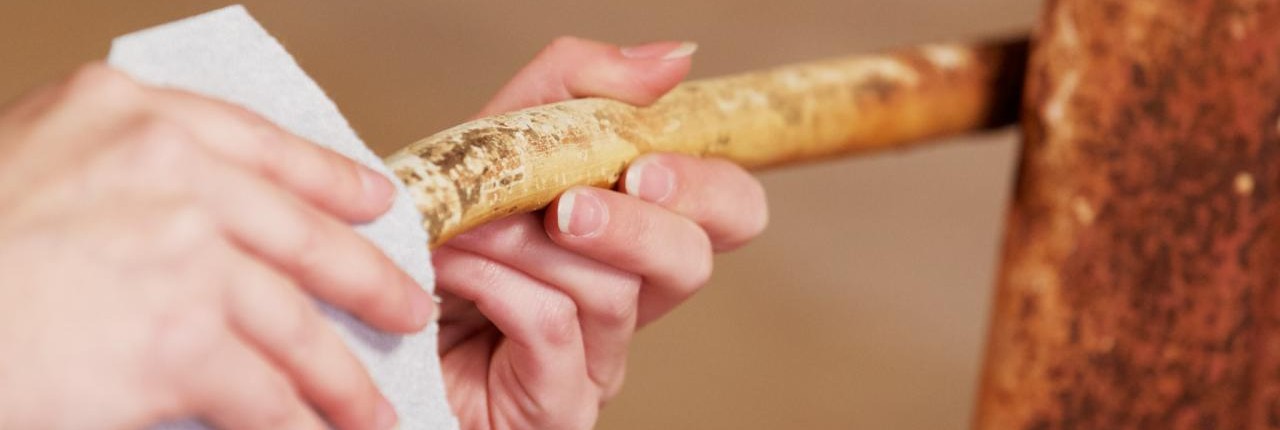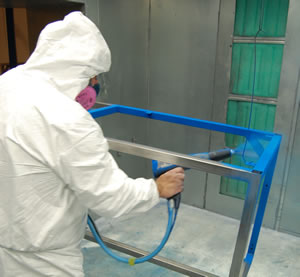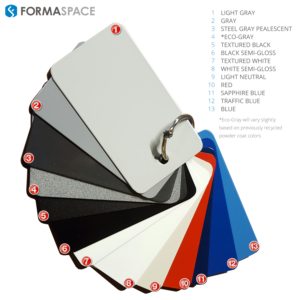Powder coating the metal surfaces of our industrial-strength furniture is just one of the ways that Formaspace ensures its products are long-lasting, which is reflected in our 12-year guarantee.
What is Powder Coating and how does it protect your Furniture Investment?
We are often asked this question: What is powder coating and why is it so effective at preventing corrosion and protecting metal parts?
You may have had your first encounter with powder coated parts without even realizing it.
For example, higher-end bicycle frames have been powder-coated for many years. Powder coating protects the metal parts (like our bench frames) from corrosion. It also provides a much tougher surface to withstand rough wear and tear compared to traditional painted surfaces.
The powder coating process produces a thin but very tough film of thermoplastic that fully envelops metal parts. During the heat curing process, the thermoplastic powder begins to melt, forming a smooth gel that blends over the metal surface
The final product is a tough yet resilient, hardened layer of plastic that provides a level of corrosion and ‘wear and tear’ protection far superior to traditional corrosion protection treatments, such as chrome plating, zinc coating or painting.
Have You Been a ‘Victim’ of Corrosion?
So why do we go to all this trouble here at Formaspace to powder coat the metal parts in our furniture products? The reason is we build our products to last.
Of course, not every manufacturer takes the time to protect their products. But then again, not every manufacturer stands behind their products with a 12-year guarantee the way Formaspace does.
Have you purchased a product only to discover that it rusts to pieces before your very eyes?

In recent years many of us have experienced poorly made products without adequate corrosion protection. Do one or more of these scenarios seem familiar?
- You or a friend purchased an imported children’s bicycle from a deep discount store and the frame, wheels and fenders become hopelessly corroded within the first year or two.
- You or a friend purchased a shiny new pair set of “metro” style storage shelves, and within a couple of years, they have rusted so badly you have to move them from the kitchen pantry to the back of the garage.
- You or a friend purchased a basic white refrigerator. Within a few years, bubbles of rusted metal begin to appear, first near the compressor, then at the hinges, and finally near the handle and seams.
According to Researchers, Corrosion Costs Americans Billions of Dollars
Back in 1972, the National Association of Corrosion Engineers (NACE), estimated that corrosion cost the American economy $10 billion dollars a year; this estimate was soon raised to $70 billion by Battelle Research Institute. By 2001, some experts believed the total cost of combating corrosion on our nation’s infrastructure, including repairing or replacing corroded bridges, traditional and nuclear power plants, water delivery and sewer piping systems was well north of $600 billion dollars.
In 2013, NACE conducted an updated world-wide economic study, which estimated that corrosion costs the global economy $2.5 trillion dollars — or 3.4% of the world’s global Gross Domestic Product (GDP).
What can be done? NACE encourages organizations to implement a thorough Corrosion Management System (CMS) to reduce economic losses due to waste caused by corrosion.
The Formaspace Corrosion Management System: Powder Coating over American-Made Steel
We’re doing our part to fight corrosion. Here at Formaspace, we take a comprehensive, multi-step approach to maximize the life of our furniture products – by taking these steps to prevent corrosion:
[KGVID autoplay=”true” loop=”true”]https://formaspace.com/wp-content/uploads/2016/12/powder_top_vidf.mp4[/KGVID]
- We use the highest-quality, American-made raw materials for making our products. For example, we only use top quality, locally-sourced American-made steel.
- We manufacture all our products in the USA, here at our 60,000 square-foot factory in Austin, Texas.
- We build all of our furniture to order, including performing all the necessary sheet metal fabrication, milling, and welding.
- We have an industrial powder coating facility on-site, which allows us to powder coat all metal parts on site (including shelving, cabinetry, doors and heavy-duty frames) – without the need for any parts to leave the building before they are fully protected against corrosion.
- All parts are assembled to check for fit and finish, then carefully disassembled and packed for shipment to you, our client.
These steps allow us to provide the highest quality protection against corrosion. That’s another solid reason why we stand behind our work with our full 12-year guarantee, one of the longest in the furniture business.
What’s the Process for Manufacturing Powder Coating Material and Applying it to Furniture?
Let’s look at each step of Powder Coating in more detail.
Preparing the Raw Powder Coating Material
First up is the manufacture of the raw material used in powder coating, which comes in dry granular form. The process the supplier uses to make these granules starts with mixing batches of polymer plastic together with colorants and other chemicals to produce a particular color shade – with unique surface characteristics, such as matte or full gloss surface finish, built-in UV protection, etc. Once the plastic mixture is ready, it’s rolled out into flat sheets, which are then sliced into thin strips, then chopped into small granules, known as ‘chips.’ Formaspace then purchases this raw powder coating material from the supplier to coat the metal components of our furniture.
Preparing the Metal for Powder Coating
After the unfinished metal furniture components are completed at one end of the Formaspace factory floor, they are transferred to our powder coating line. Here, the bare metal surfaces are cleaned again using a phosphate detergent to remove any residual surface contamination (such as protective oil coatings) then the metal parts are baked in an oven to remove all moisture before starting the powder coating process.
Applying Powder Coating to Electrostatically Charged Metal

When the system is turned on, it produces a very high voltage (up to 25,000 kV) at a very low amperage. Applying this electrostatic charge during the spraying step helps attract the powder coating granules, causing the powder spread out and attach more evenly across the metal surfaces.
Meanwhile, the operator prepares the powder coating granules for spraying, often using a ‘fluidizer’ to help suspend the particles, so they flow better. (Unlike paint, no liquid solvents are needed.)
When spraying, the operator can make adjustments to get the smoothest powder application for a given shape target. For example, the operator may choose one style of the spray nozzle to spray inside a desk drawer, and a different type of spray nozzle to spray large, flat surfaces. The operator can also electrify the nozzle (with an opposite charge) to help guide the powder to the metal surface. Finally, the operator can modulate the electrical charge on the metal targets themselves in order to optimize the powder density on different shaped objects.
Using High-Temperature Heat to Melt the Powder Coating to Produce a Hard, Durable Finish
After the spraying process is complete, the racks holding the metal parts (now evenly coated with fresh powder) are transferred to our large, industrial-sized ovens.
Initially the temperate is raised until the chemical powder begins to ‘gel’, e.g. starts to melt (like glass handled by a glassblower) and flow evenly across the surface of the metal parts.
After a smooth surface forms, the temperature is adjusted to allow the material to ‘cure’ — this is a chemical process by which the thermoplastic develops long, cross-connected polymer chains throughout. It’s these polymer chains that give powder coated surfaces their characteristic strength and durability.
The finished product is allowed to cool down before it returns to the final manufacturing stages for quality control inspection, test assembly, and shipping.
Environmental Advantages of Powder Coating over Traditional Painting

From the description of the process of powder coating above, you may pick up upon the fact there are no liquid aerosols or solvents used in the process. Consequently, no volatile organic compounds (VOCs) are released during the powder coating process — unlike traditional painting processes which can contribute to air pollution.
There’s also less potential waste involved, as the unused powder or overspray can be is collected and used again (We’ll touch on this again shortly).
So if you’re looking for more ‘green’ sustainable solutions, powder coating is environmentally superior to painting in a number of ways:
- Powder coating does not release solvents or VOCs into the atmosphere.
- Because the powder coating process uses solid materials (with no solvents or VOCs), it’s safer for the operator applying the material compared to traditional paint spraying.
- Unlike traditional painting processes, where significant amounts of material are ‘lost’ to overspray, nearly all the unused powder coating material can be collected and recycled for further use.
- You may earn LEED recycling credits when you specify our Eco-Gray is both earth and wallet friendly.
- Compared to powder coated products, painted products are inherently less durable and thus less environmentally friendly. For example, painted surfaces will typically either need to be stripped and repainted at least once to extend their product lifespan – which means additional applications of solvents and paint – or worse, the corroded product is discarded before reaching its full potential lifespan.
- Because it wraps around edges of the metal, powder coating is able to protect the edges of your furniture from damage or corrosion compared to traditional painting techniques.
Formaspace’s Eco-Gray Powder Coating: Part of our Recycling Program for LEED Credits
If you’re familiar with obtaining LEED credits for your sustainable building project, you know that recycling and reusing materials can help you earn valuable credits.
Did you know that Formaspace conducts an intensive recycling program throughout our manufacturing process? We recycle and reuse as much material as we can, including shipping pallets and packing materials, wood and metal scraps, and even overspray from the powder coating process. Our modular furniture designs are also recyclable too. Unlike fixed casework, Formaspace modular furniture can be easily disassembled at one location and reassembled at a new location. Modular designs not only protect your investment but also protect the environment: reusing modular furniture in new locations prevents large quantities of materials from being discarded into landfills.

For those customers who want to have the most recycled content in their furniture, we recommend our Eco-Gray powder coating solution: it’s formulated from the excess powder coating material that gets oversprayed during the powder application process. This material, which is gray with flecks of color, can count as a recycled material for LEED certification. Contact your Formaspace Design Consultant for more information.
Frequently Asked Questions about Powder Coating Formaspace Furniture
Q: I want the industrial look for my office — the raw metal frames look great in your photo gallery, but I am concerned about corrosion.
A: Get the best of both worlds by choosing a clear matte (transparent) powder coating over the raw metal. You’ll get the desired industrial-look while gaining the same protection on your investment from corrosion. Contact your Formaspace Design Consultant for more information.
Q: As interior designers, we have specific color schemes in mind for our new office cabinetry and desk systems. Can Formaspace match specific colors when powder coating the metal surfaces?
A: Yes. In addition to our standard colors, we can provide a custom color match based on your physical sample or PMS color. There may be an additional service charge for color matching, depending on your order size. Generally, we can match most colors, but some colors are difficult to achieve when manufacturing the raw thermoplastic powder coating granules (unlike paint, various granules colors cannot be mixed to create a new tint — mixing granules would make a mottled color pattern instead.)
Q: We like some of the outrageous colors, like bright red and orange fluorescent tints, metallic ‘candy’ colors, that are available for powder coating. Can Formaspace supply these?
A: Yes. We can supply custom transparent tints and metallic effect candy colors. Some of these colors may not be inherently resistant to UV light exposure so that we may recommend an additional top powder coat with UV protection layer. Ask your Formaspace Design Consultant for recommendations and samples.
Q: I am interested in stainless steel furniture. Is it normal to treat stainless steel with an additional transparent powder coat?
A: It’s possible to do this but an uncommon choice. If you are in a laboratory, pharma or food handling setting, it would be customary to use bare stainless steel surfaces due to code or safety requirements. Bare stainless steel can also handle very high temperatures and withstand solvent spills that could damage powder coated surfaces. If you have a different application and you want to opt for powder coating, contact your Formaspace Design Consultant for more information and request a sample to see what the finished surface would look like.
Q: How can I keep my powder coated surfaces looking like new?
A: We recommend cleaning powder coated surfaces on a regular basis using mild soap and warm water to prevent the buildup of surface contaminants. Never use harsh chemicals or solvents/thinners. Clean up any chemical spills immediately.
Q: Can I get a matte surface finish on my furniture?
A: Yes. Be sure to tell your Formaspace Design Consultant you want a matte surface, and they will advise you on your available options.
Q: We accidentally cut a small nick in our powder coated furniture. How can we repair it on the site?
A: If the nick is small, you can touch it up with automotive touch-up paint, model car / airplane paint or even nail polish (if that color matches best.) If the damaged area is very large, a reputable automotive paint and body shop can likely repair the damage. Alternately, Formaspace can manufacture a replacement part. Contact your Formaspace Design Consultant for details.
Formaspace is Here for You
We hope this in-depth look at powder coating will help inform you about how to protect your furniture investment from corrosion.
Want to know more? Contact a dedicated design consultant who can help answer all of your questions.









